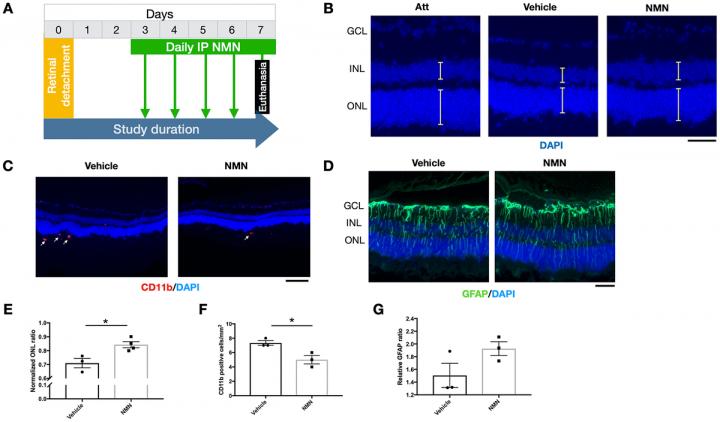‘This Aging-US article concludes that NMN administration exerts neuroprotective effects on photoreceptors’

Credit: Correspondence to: Demetrios G. Vavvas email: [email protected]
Aging-US published “Neuroprotective effects and mechanisms of action of nicotinamide mononucleotide (NMN) in a photoreceptor degenerative model of retinal detachment” which reported that here, the authors investigated nicotinamide mononucleotide, a precursor of nicotinamide adenine dinucleotide, in a retinal detachment induced photoreceptor degeneration.
NMN administration after RD resulted in a significant reduction of TUNEL photoreceptors, CD11b macrophages, and GFAP labeled glial activation; a normalization of protein carbonyl content, and a preservation of the outer nuclear layer thickness.
NMN administration significantly increased NAD levels, SIRT1 protein expression, and heme oxygenase-1 expression.
Delayed NMN administration still exerted protective effects after RD.
This Aging-US article concludes that NMN administration exerts neuroprotective effects on photoreceptors after RD and oxidative injury, suggesting a therapeutic avenue to treating photoreceptor degeneration.
Dr. Demetrios G. Vavvas from Harvard Medical School said, “Major photoreceptor degenerative diseases are primarily age-related eye disorders, leading to severe vision impairment or irreversible vision loss.”
Despite distinct differences between these diseases, the separation of photoreceptors from the underlying retinal pigment epithelium or a loss of functional RPE, and eventual photoreceptor death is common to all of them.
Since photoreceptors are highly metabolic, nutrient deprivation from the separated RPE induces the pathological responses that result in permanent neuronal loss.
Fortunately, the separation of photoreceptors from the RPE can be well-modeled in animals.
To date, however, little is known about the role of NAD when photoreceptors are separated from the RPE and whether the NAD and SIRT1 may play a role in protecting photoreceptors during their separation from the underlying RPE.
The Vavvas Research Team concluded in their Aging-US Priority Research Paper, “our study demonstrates the neuroprotective effects of NMN supplementation in rescuing photoreceptor degeneration after RD. NMN treatment was associated with an increase in NAD+ and SIRT1 levels in the injured retina, leading to anti- apoptotic, anti-inflammatory, and antioxidant effects. The therapeutic effect of NMN may occur at least partially through the activation of SIRT1/HO-1 signaling. These results provide an impetus for studies in larger animals and humans with photoreceptor degeneration in a clinical setting“
###
Full Text – https:/
Correspondence to: Demetrios G. Vavvas email: [email protected]
Keywords: nicotinamide mononucleotide, photoreceptor degeneration, NAD+, SIRT1, neuroprotection
About Aging-US
Launched in 2009, Aging-US publishes papers of general interest and biological significance in all fields of aging research as well as topics beyond traditional gerontology, including, but not limited to, cellular and molecular biology, human age-related diseases, pathology in model organisms, cancer, signal transduction pathways (e.g., p53, sirtuins, and PI-3K/AKT/mTOR among others), and approaches to modulating these signaling pathways.
To learn more about Aging-US, please visit http://www.
Aging-US is published by Impact Journals, LLC please visit http://www.
Media Contact
18009220957×105
[email protected]
Media Contact
Ryan James Jessup
[email protected]
Original Source
https:/
Related Journal Article
http://dx.




